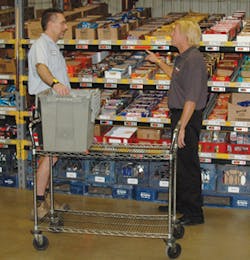Twin Cities' Vendor Uses MEI Easitrax Software To Revamp Warehouse And Routes
D&R Canteen of Rochester, Minn. has looked beyond their initial scheduling and inventory efficiency gains to cut costs even more from its management software. With approximately 3,000 DEX-capable machines and eight years working with MEI's Easitrax vending management software, D&R is taking full advantage of the software's reporting capabilities for pre-kitting, forecasting, and reporting to streamline operations — in the warehouse and on its routes.
Stu Riemann, project manager at D&R Canteen, and his team have integrated the numerous DEX capabilities of their machines with Easitrax.
Within minutes of running a report on coin changers in the field, Riemann was able to remove more than $65,000 worth of change from the machines, take it off the street, and deposit it directly into D&R's bank account.
Other capabilities soon became evident.
D&R's general managers regularly run ranking reports on machine profitability to relocate poorly performing machines and reduce the need to purchase new machines.
Identifying machines with the least amount of customer traffic allows Riemann to make adjustments to route schedules. In the first year, D&R eliminated multiple routes, saving an estimated $150,000 per year.
Riemann has been able to use data to predict consumption of fresh food, including sandwiches, cookies and pastries. This information, along with Easitrax food forecasting functionality, has significantly reduced waste levels of these perishable items. Another report lets operators track price increases as they are initiated on each machine, increasing driver accountability.
"We knew we had a powerful tool, but we were only using about 45 to 50 percent of its capabilities," said Riemann. So, D&R began overhauling its warehouse operations for pre-kitting, starting with the installation of Innovative Picking Technologies Inc.'s pick-to-light system that integrated seamlessly with the Easitrax software. The system eliminated the need for drivers to spend time picking products.
With the pick-to-light system, D&R racks items in the most efficient way for pre-kitting each machine's required product for the day. When a picker inserts an order into the system, the racks light up, showing which items and how many to put in the tote. The system lights up heavier items first, such as soda and candy, so they are selected before chips and pastries, to ensure that each item arrives at the machine in the best condition possible.
The pre-kitting function is fast and efficient; training is simpler for low-cost warehouse personnel, and errors have virtually been eliminated.
With his warehouse and picking process streamlined, Riemann turned his focus to forecasting. He knew that mining machine data to better understand usage patterns was the only way to eliminate the "counting trip" for drivers and increase the number of machines each driver could service.
Every night, after drivers return their handhelds with all of their route data, D&R runs reports to determine which machines need to be filled and what products they require. Only those items are pre-kitted for the next day.
When the drivers arrive in the morning, D&R knows exactly how many items need to be filled in each machine. By only delivering what is needed, drivers have more time to service more machines in a day and the amount of products in the truck is greatly reduced. And, because trucks are no longer weighed down with unnecessary products, they last longer, get better gas mileage and require less maintenance.
"When you zoom in and look at the data, you quickly see that there are things happening in the field that are costing your company a lot of time and money," continued Riemann. "The data is there; you just need to access it."
Forecasting has allowed Riemann to take control of, and automate, a number of key data points that previously were controlled by route drivers – namely item level tracking. Since removing driver control of the data, D&R has achieved a .008 over/short percentage. "I brought our drivers in and showed them how we were using the software, said Riemann. "After that, we never really had issues with overs/shorts. The drivers understood that we were tracking the data closely and could account for every sale from every machine."
The system also helps with preventive maintenance. Riemann runs a report each morning that tells him the last time someone inserted a dollar bill into each machine. If a machine hasn't collected any bills the previous day, he arranges for that machine to be serviced as soon as possible, preventing downtime, lost sales and frustrated consumers.
"Our machines are always full and almost always working properly, so they are capable of making the sale whenever consumers want to purchase snacks," he said. In fact, although the U.S. average is 17 percent sold down (from last visit) at time of replenishment service, D&R now approaches 50 percent sold down at time of replenishment.
By using telemetry, D&R is hoping to achieve the same level of service for its remaining machines, which are in more transient locations, such as airports, military bases, etc. Those machines are more difficult to manage due to their unpredictable usage patterns.
"Having remote access to real-time data will take our operation to the next level," said Riemann. "Telemetry technology has the potential to help us cut more routes, find more ways to be efficient and continue increasing our profitability. I really don't see how a vending operator will survive in the future if they don't do some level of advanced forecasting and pre-kitting."
